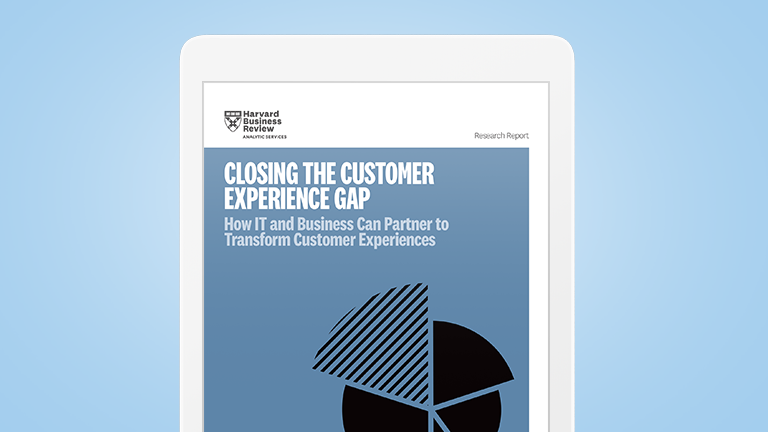Closing the Customer Experience Gap


Analytic Services Research Report, Sponsored by Salesforce
Chapter 4: The Future of CX: Advanced Analytics and Artificial Intelligence
A significant strategic shift is coming in terms of the tools companies use to deliver superior customer experience. Website and email channels, which are more dominant today, will become much less business-critical. Meanwhile, mobile apps, chatbots, and other AI-driven tools will grow in importance.
But the biggest and most significant shift will be in the use of advanced predictive analytics to drive data-driven customer experience decisions.

The senior vice president of strategic analytics for the marketing services provider is increasing investment in technologies that offer more control to the customer, including augmented reality and self-service systems as well as AI. Of course, emerging capabilities such as advanced analytics, process automation, or chatbots cannot transform customer experience in isolation. Only companies that put in place the cultural, structural, and technological foundations to take advantage of such new approaches will extract the full value from them.
“If you want to be an experience-led business, any technology that can provide a more personal and more contextualized experience is going to be very important in the future,” said the CCO of the institutional investment and benefits company, which is already placing small bets in the areas of machine learning and robotic process automation. “One of the most important skill sets of the future will be taking these new modular technologies and integrating those for single customer view, channel alignment, and the delivery of contextual customer experiences. That’s the real challenge—but it’s also the real competitive advantage.
“THE BIGGEST AND MOST SIGNIFICANT SHIFT WILL BE IN THE USE OF ADVANCED PREDICTIVE ANALYTICS TO DRIVE DATA-DRIVEN CUSTOMER EXPERIENCE DECISIONS”
New Ways to Measure Customer Success

While customer satisfaction is one metric that leaders use to take the temperature of their transformation efforts, it is typically not the sole measure relied upon—or even the most important one. Leaders are considerably more likely to look at metrics such as customer lifetime value, customer advocacy, and customer retention than their counterparts—an approach that better positions them to develop and implement more targeted and fruitful customer experience strategies and tactics going forward.
“Surveys are only one piece of the puzzle,” explained the credit union CEO. “Identifying actual behavior is far more important and gives us insight into what customers actually do versus what they say they do.” The online fashion retailer uses a combination of information from surveys, focus groups and individual interviews, CRM data, and online behavioral data to monitor and adjust customer experience efforts. “The combination enables us to overcome the shortcomings of any one method and build a more holistic view of results,” said the company’s performance marketing manager.
Net promoter scores and customer satisfaction figures give the institutional investment and benefits company common metrics to compare across business units and against the competition, but they serve as only a “high-level read on how we’re [doing] with customers,” said the company’s CCO. “Beyond that, we focus on the metrics that matter. Unsatisfied customers can stay because they don’t see alternatives. Satisfied customers still leave. So for us, the key metrics are things like customer friction: how much effort it takes for a customer to get something done with us, and how we can reduce that.”
The Customer Experience Payoff
Of course, what really matters to any business is the bottom line. Customer experience efforts are only a priority insofar as they benefit the bottom line. And it’s becoming clear that they do.
Leaders are outperforming others on the customer experience leadership, cultural, and skills fronts, which explains why they are also more effective on the process, technology, and organizational alignment fronts.

That has led these organizations to outperform their rivals and see stronger revenue growth than their competitors. A coordinated, clear, and fully integrated customer-centric transformation yields not just improved customer experience quality but also business growth.
The leaders interviewed for this report were convinced that their customer experience focus was critical to their overall performance and would continue to be so for the foreseeable customer experience strategies and tactics going forward.
Their biggest concerns were not whether the efforts put into customer focused transformation would pay off, but the challenge of making sure that customer experience efforts remain a top focus.
“There are always strategic choices to be made, and other priorities can overshadow the benefits of improving the customer experience. Nonetheless, we aim to improve the customer experience whilst, for example, replacing legacy systems,” said the customer experience leader at a financial services company. At the online retailer in hypergrowth mode, “a lot of things are happening,” says the performance marketing manager, noting that the launch of a new collection can take precedence over consolidating and analyzing customer data. “Getting resources to lock up the effort is always a challenge. It’s not a matter of buy-in.There is complete alignment and agreement that this needs to happen. But things are happening so fast, it can be hard to keep up with everything.” The vice president of customer experience at the terminal technologies provider agreed. “Overcoming competing priorities is the biggest challenge we face on all customer experience fronts.”
Ongoing vigilance will be important for all companies. Even leaders that may be ahead of their rivals in their customer experience delivery have by no means achieved mastery. They have plenty of scope to improve their data usage through a single-source of customer intelligence system. They too suffer from budgetary constraints and the continually growing deluge of customer data.
“There will always be new data elements, and tools are getting better and better,” said the credit CEO. “We’re doing reasonably well. But it’s something we can never become complacent with. It’s a journey.” And as it is one without a foreseeable end, what the best companies can do is map out a direction and pave the way for ongoing improvement and innovation. “Anyone that says they’re done with this is mistaken, particularly as technologies continue to evolve at a breakneck pace,” says the CCO of the institutional investment and benefits provider. “Our goal is to lay a solid foundation and create a technology environment that will serve us well in the future.”
Call to Action
There is no debate: Customer experience is and will continue to be a key differentiator for all companies. While there are significant cultural, organizational, and technological barriers to customer experience transformation, there is also clarity around the requirements to overcoming them. Customer experience leaders will:
- Have unambiguous executive support for customer experience transformation
- Develop a clear customer experience transformation strategy built on desired customer experience outcomes
- Create a customer-centric culture throughout the enterprise
- Break down customer data and organizational silos
- Align IT priorities with customer experience demands
- Invest in next-generation customer technology that can deliver a single source of customer insight across functions
- Partner with vendors and consultants with experience and skills required to collect, analyze, and act on expanding volumes of customer data
- Empower employees to deliver and innovate around customer experience
These efforts to reorganize around the customer will only become more important as customer requirements evolve and expand and sources of customer data continue to increase. Those companies that are not able to adapt to meet customer demands with agility and speed will quickly lose customers—and revenue—to competitors that do.

Want to read the full report?
The Age of the Customer-Centric CIO
overview
Chapter 1
Chapter 2
Chapter 3
Chapter 4
Want to read the full report?
Questions? We’ll put you on the right path.


